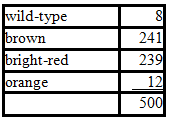An organism is discovered that thrives in both the presence and absence of oxygen in the air. Curiously, the consumption of sugar increases as oxygen is removed from the organism's environment, even though the organism does not gain much weight
This organism _____. A) is a normal eukaryotic organism
B) is photosynthetic
C) is an anaerobic organism
D) is a facultative anaerobe
D
You might also like to view...
Where on a neuron would you expect to find myelin?
A. round the dendrites B. at the axon hillock C. along the axon D. at the synapse
What is the genotype of the wild-type mother of these progeny?
In Drosophila, the autosomal recessive pr and cn mutations cause brown and bright-red eyes, respectively (wild-type flies have brick-red eyes). Flies who are homozygous recessive at both pr and cn have orange eyes. A female who has wild-type eyes is crossed to an orange-eyed male. Their progeny have the following distribution of eye colors:

A) pr cn / pr+cn+
B) pr+cn / pr+cn
C) pr+cn / pr cn+
D) pr cn+ / pr cn+
E) pr cn / pr cn
Cells produced by dividing B or T cells may immediately begin to destroy an invader. These cells are
called a. effector cells. b. memory cells. c. dendritic cells. d. phagocytes. e. fibroblasts.
Which statement concerning neurotransmitter release at the effector is true?
a. Preganglionic parasympathetic neurons release serotonin. b. Preganglionic sympathetic neurons release norepinephrine. c. Postganglionic parasympathetic neurons release norepinephrine. d. Postganglionic sympathetic neurons release acetylcholine. e. Postganglionic sympathetic neurons release norepinephrine.